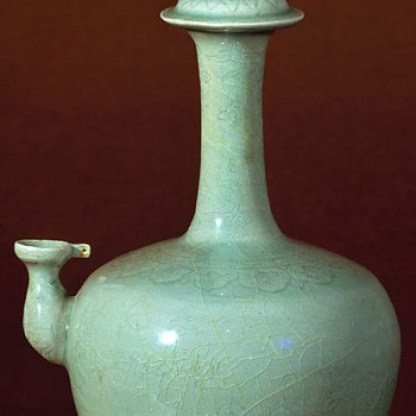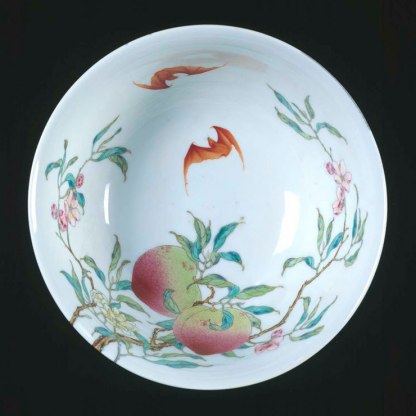Posset pot and salver, 1685 and 1686

On 6 January 1668, Samuel Pepys hosted a party at his home. He later recorded the event in his diary:
By and by to my house, to a very good supper, and mighty merry, and good musick playing; and after supper to dancing and singing till about twelve at night; and then we had a good sack posset for them, and an excellent cake ... and so to dancing again, and singing, with extraordinary great pleasure, till about two in the morning.
Posset was a drink consisting of warm, sweetened milk curdled with wine or ale, and mixed with spices. It could be sipped or, if made to a thicker consistency, eaten with a spoon. It survives today in the form of egg-nog, a favourite Christmas tipple in the United States.
Posset was traditionally drunk at weddings by the bride and groom before retiring to the bedroom, and it was used medicinally and as a nightcap as late as the twentieth century. This elaborate, carefully decorated container for the beverage was probably used at social events, like that recorded by Pepys.
Two pairs of twisting, snaky handles adorn the body and the lid, which is surmounted by a globe on which a bird rests. A spout for sucking up the posset runs from the bottom of the pot. The whole rests upon a salver, which was necessary for catching drips from the spout. The salver here, like the pot, is supported by small bird-shaped feet, although other aspects of the decoration indicate that it was not orginally made to match this particular vessel.
English delftware, with its characteristic blue and white decoration, derives its name from the fine tin-glazed earthenware made in the the Dutch city of Delft. But it was also influenced by Italian and French pottery and Chinese porcelain. Individuals travelling in the East had been bringing back Chinese porcelain since the middle ages, but the opening of new trade routes between China and the West in the seventeenth century, and the creation of the East India Trading Companies, led to a sudden influx of luxury East Asian goods to Europe – silks, lacquer and ceramics.
The decoration of this pot and its lid clearly shows Eastern influence: elegantly dressed Chinese figures walk together or sit alone in a landscape of rocks and foliage. Chinese influence upon the decorative arts in Europe became pervasive in the eighteenth century, and to this day blue and white ‘willow pattern’ tableware remains popular.
Themes and periods
Data from our collections database
Tin-glazed earthenware posset pot and cover, painted in cobalt blue with Chinese figures and a stag in landscapes
Posset pot with cover and stand (see C.1504B-1928). Buff earthenware with very pale turquoise-green tin-glaze, painted in cobalt blue. The pot is bulbous, with wide neck and two handles branching into corkscrew coils and decorated with applied serpents; between them, on one side, is a sucking spout. On the cover, which is domed, is a knob in the form of an openwork globe with a bird perched upon it, flanked by handles similar to those on the pot. The pot and the circular stand each rest on three feet in the shape of small birds. The pot and the cover are painted with Chinese figures in landscapes, in the manner of late Ming porcelain; under the base the initials and date 'C T A 1685'. On the stand there is a man and woman in European dress drinking (perhaps intended as Lot and his daughters), with sun, moon and stars in the sky and the same initials and date '1686'.
Purchased from Mr Stoner in London for £59 on 1 May 1917 by Dr J.W.L. Glaisher, FRS, Trinity College, Cambridge
Legal notes
Dr J.W.L. Glaisher Bequest
Acquisition and important dates
- Method of acquisition: Bequeathed
- Dates: 1928-12-07
Dating
Previously uncertain whether the posset pot was Lambeth or Bristol. See Garner, 1972, in documentation, for attribution to Lambeth. See Archer, 2007 for attribution possibly to Brislington. The stand is catalogued separately because it has unrelated decoration, and may not originally have been with this posset pot.
- 17th Century, Late
- Charles II
- James II
- Production date: dated AD 1685
Maker(s)
- Brislington Pottery Factory
Note
Previously uncertain whether the posset pot was Lambeth or Bristol. See Garner, 1972, in documentation, for attribution to Lambeth. See Archer, 2007 for attribution possibly to Brislington. The stand is catalogued separately because it has unrelated decoration, and may not originally have been with this posset pot.
Place(s) associated
- Brislington
Materials used in production
Read more about this recordOther highlight objects you might like
Suggested Curating Cambridge products
Sign up to our emails
Be the first to hear about our news, exhibitions, events and more…





